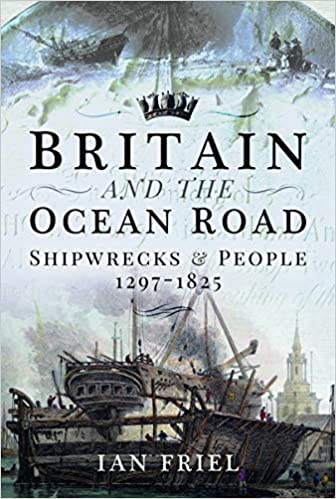Reviewed by Rory McAlevy
To study history is to study people, and Ian Friel captures that exquisitely in “Britain and the Ocean Road.” His work centers on the individual human experiences that illustrate the story of Britain’s ascendency to a dominant ocean power. Armed with this poignant narrative lens, Friel traces a national heritage of seagoing through 8 powerful chapters focused on shipwrecks and the crucial interpretations that reveal the human stories that lie with them.
Ian Friel is a maritime historian who focuses on the material aspects of naval heritage. Coming from a museum background, Friel is very well qualified to trace the minute details of Britain’s rise to a Mahanian paradigm of global sea power. While trade, exploration, and warfare are strong themes in the book, they never become the dominant focus of any of the narratives in the chapter.
As the starting point for his narrative of British seafaring, Friel presents the 1297 wreck of the St. Cross, which participated in King Edward I’s invasion of Flanders. This focus is in line with Friel’s earlier work on the navy of King Henry V while still resisting an overly broad focus on kings and geopolitics. Instead, Friel emphasizes the bitter rivalry over the medieval herring trade between the English trading ports of Great Yarmouth, from which the St. Cross hailed, and the Cinque ports. He also provides terrific, easy to understand explanations of sailing technologies from the period. The early ships of Britain were clinker built based on Scandinavian boat designs and utilized square masted sails. Friel always strives to put the reader on the deck of the ships he highlights, and puts names, faces, and personalities into the grand historical context that he sketches in this work.
Covering the topic of trade growth through several stages, Friel first highlights the local trade systems, especially of wine, that England was engaged in with close neighbors. For the medieval period, British sea power was largely limited, with the pilgrimage of the Cog Anne to the Holy Land representing the extreme extent of its reach. As Friel covers the beginnings of the empire-building East India Company, he further sketches the very limited ability of the early British state and related organizations to command the maritime domain. From the early pilgrimage trade highlighted in Chapter 2 to the Eastindiaman Trade’s Increase which carries the narrative in Chapter 4, Friel makes clear that British seapower was initially built on high ambitions and big gambles.
That same theme of power projection continues in Friel’s examination of the early warships of the Tudor reign. The early Tudor’s devoted an outsized portion of their spending to constructing two purpose-built warships, the Regent and the Sovereign. Even though they did not survive long, they marked the beginning of a more permanent Royal Navy. In the later descriptions of First and Third Rate ships of the line, which were a staple of the intense Napoleonic conflicts, Friel emphasizes how the continuous investment of the British government from the Tudor period onwards helped establish and maintain the Royal Navy’s claims to supremacy. Interestingly, Friel notes that British claims of domination often preceded the arrival of underlying might. Here, Friel excels in contrasting the mythology versus the reality of British sea power.
In cutting to the truth underlying often mythologized and sometimes uncomfortable topics, in Chapter 5, Friel dives into the tumultuous life of the pirate crews of a series of ships named the Resolution. Discussing the rough forms of democracy that the crew practiced, yet never shying away from the fact that poverty and need were one of the biggest recruiting factors in that life of crime, Friel resists romanticizing the era of piracy. Similarly in Chapter 7, he does not shy away from discussing the horror and reality of the slave trade in which Britain participated. Never does he offer relativistic apologies for the actions of slavers; though he acknowledges the ways in which the resulting wealth was sometimes hypocritically put to “good causes.” Again highlighting the human experience, he offers vivid images of both the crew and the captive Africans they were transporting. Admirably, Friel sketches a realistic interpretation of these darker parts of Britain’s maritime heritage, aiming to provide a full and accurate account of that history.
In the last chapter, focusing on exploration, Friel once again highlights a lesser-known story, that of an Arctic expedition which failed to find a Northwest passage but succeeded in bringing back virtually all of its crew despite suffering a shipwreck. Friel chooses to emphasize a caring captain over mission success. Friel never loses sight of the personal, even as he recognizes how such larger objectives were motivated by politics and imperialism as much as science.
This work is a perfect introduction to the massive topic of British sea power; it does not go in depth into the battle of Trafalgar or the empire building processes of the East India Company, but it does paint in broad strokes Britain’s development as a sea power. More importantly, with each argument Friel presents, he offers as waypoints the critical examples of ships and their crew members, vividly bringing them to life for the reader. For a general audience interested in British maritime history in the age of sail, this work offers a great balance of informative detail and broad, historically sound interpretations of Britain’s development. Friel’s research, some of which is original and some of which draws on other expert sources in the fields of history and archaeology, robustly supports the thesis of the work, and therefore offers significant value for interested scholars.
Rory McAlevy is studying history and archaeology at the University of Virginia , and is currently an intern at the Naval Historical Foundation.
Britain and the Ocean Road: Shipwrecks and People, 1297-1825 (Ian Friel, Pen & Sword, Barnsley, South Yorkshire, Great Britain, 2020).



Pingback: Breaking Seas, Broken Ships: People, Shipwrecks & Britain, 1854-2007 | Naval Historical Foundation